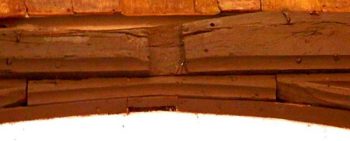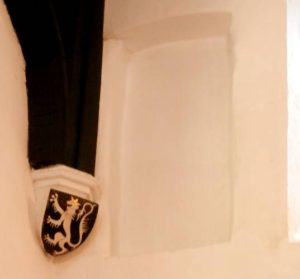Most late medieval churches had a wooden screen dividing the people’s nave from the holy area of the chancel. The lower part, to about waist height, was made of solid wooden panels, usually painted with the patron saint and other popular saints, with a central door.
Elaborately carved posts supported a loft or gallery which in turn supported the great central crucifix known as the Rood, flanked by Mary and John. A painting of Judgement Day or Doomsday was set in the tympanum of the chancel arch above or behind the Rood group.
The Rood group and screen thus summarised the essentials of medieval Christian belief and was still a ritual prop which served as a focus of worship, particularly on Palm Sunday when the Clerk often stood in the Rood-loft at the foot of the Cross to sing the service.
 The Doom survives in Penn and what appears to be the opening to the Rood-loft staircase was found set in the south wall, during restoration work in 1952. In the centre of the wooden beam above the chancel arch there is still the socket which held the Rood in place with a hook on each side to support the figures of Mary and John.
The Doom survives in Penn and what appears to be the opening to the Rood-loft staircase was found set in the south wall, during restoration work in 1952. In the centre of the wooden beam above the chancel arch there is still the socket which held the Rood in place with a hook on each side to support the figures of Mary and John.
One or more candles were kept burning all the time on the Rood loft and parishioners provided for them in their wills. Thus in 1513, William Grove left a sheep, and in 1544, Thomas Bovingdon bequethed 4d to the Rood-light of Penn. The burning of any lights except for two candles on the altar was strictly forbidden by an injunction of 1547 after Henry VIII’s death released the full vigour of reforming Protestant zeal. It is therefore very surprising to find that, as late as January 1549, Roger Playter could still bequeth 2d to the Rood-light at Penn and 2d to the priest ‘to say masse in the chapell for my soule at a time convenient‘ .
© Miles Green, August 2000.

